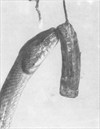|
Q:
|
Leo with horrible joint growths
|
|
hokay, so a friend rescued a leopard gecko. the poor thing is nearly wasted away, and has horrible growths on its joints. shoulders and hips. i have no idea how it moves, or even attempts to catch food. supposidly the owner said it ate every 3 weeks, i can see that. they also want it back if we can fix it. i told my friends, no. you need to lie to them, saying it died if it somehow survives (i am against lying in most cases). because this is animal abuse, this poor thing has been starving, and can barely move. it takes 2-3 weeks for their tails to shrivel (i think?) and those growths didnt apear over night. so if returned this poor thing will only go back to a neglectful owner.
i will ask for them to email me a picture of her, but it is a bit graphic. the growths almost look like gout, but i dont know if leos can get that. they also look to be affecting the bones in the joints themselves. we've been feeding her via eye dropper some repta boost, to give her some energy. but im not sure what else to do for her aside from putting her down, so she doesnt suffer anymore :/
|
|
Member Comment
|
10/16/2011 3:13:43 PM
|
|
|
|
|
|
|
Author Comment
|
10/16/2011 3:29:07 PM
|
|
|
|
|
|
|
Member Comment
|
10/16/2011 3:44:00 PM
|
|

deadvenom
|
|
wish I could help. that wa sa pic of my rescue.. looks like a past MBD issue and potential gout. Eats like a monster though and walks fine
|
|
|
|
|
|
|
|
Author Comment
|
10/16/2011 3:45:42 PM
|
|

La Price
|
|
hmm, shes not doin so well. i think she may not be getting the right calcium. though she had plenty in the cage they gave us ...
|
|
|
|
|
|
|
|
Member Comment
|
10/16/2011 4:00:58 PM
|
|

deadvenom
|
|
weird..it triple posted the photo. Put calcium on her food. It's better that way!
|
|
|
|
|
|
|
|
Author Comment
|
10/16/2011 4:19:31 PM
|
|

La Price
|
|
yea, the repi-boost stuff has that. and lots of protien. she'll lick it up pretty good thankfully. but not much, which i can understand
|
|
|
|
|
|
|
|
Accepted Answer
|
10/17/2011 12:17:41 AM
|
|

bwaffa
|
|
Articular gout is the most likely culprit, and unfortunately it's quite common in captive reptiles including leopard geckos.
The pathophysiology of gout in reptiles is poorly understood - almost all our info is extrapolated from the human literature! - but the consistent risk factors seem to be renal issues (often from the use of certain antibiotics), dehydration, and inappropriate levels (or lack) of protein in the diet. Basically what happens is you get a perfect storm of physiologic and environmental factors that come together to increase the amount of normal uric acid in the blood ("hyperuricemia"). And when the concentration of a solute in solution gets high enough, what happens? A precipitate - in this case urate crystals - comes out of solution to make an insoluble solid. Since crystals don't flow easily through blood vessels, they tend to get stuck in tight places. And since the joints represent the very tightest spaces blood flows through, this is where they accumulate. These accumulations are responsible for the hard nodules you see at the joints.
If you're imagining that this is probably very painful, you're probably right. Although reptiles, being very stoic creatures, are very good at compensating for their condition, it's safe to assume their quality of life is compromised, especially as the syndrome progresses. Prognosis at advanced stages is typicallly considered "poor," but you have a few options.
Identifying and correcting the husbandry can stop the progression of disease, significantly improve the animal's quality of life, and may even help reduce symptoms over a long enough period of time. This should be done regardless. Corrective treatment is difficult though, especially since it's hard to find vets equipped to address gout. Allopurinol (or other antihyperuricemics) and antiinflammatory drugs may help to reverse signs of disease, but I can't verify whether that's even been attempted in a leopard gecko.
Get any lizard that looks like the one in the picture to a good, qualified reptile veterinarian. Discuss treatment options and prognoses with your doctor, and consider euthanasia if there's nothing you can do to correct his condition or improve his quality of life. Good luck!
|
|
|
|
|
|
|
|
Author Comment
|
10/17/2011 1:09:32 AM
|
|

La Price
|
|
thanks, i dont know if we can afford a vet. But we'll see how she does with eating blended food for a few days, we had a water dragon get better from gout pretty ok. but his wasnt as sevier as hers is
|
|
|
|
|
|
You are not logged in. If you would like to participate (it's free!), you must log
in, or Become a Member!
|
|
|
|
Most Popular Tags
Ball
,
Ballpython
,
Bci
,
Behavior
,
Boa
,
Breeding
,
Buying
,
Caging
,
Care
,
Chondro
,
Cornsnake
,
Crested
,
Crestedgecko
,
Eggs
,
Feeders
,
Feeding
,
Feedingproblems
,
Gecko
,
General
,
Genetics
,
GTP
,
Health
,
Heating
,
Humidity
,
Identification
,
Illness
,
Incubation
,
Infection
,
Leopardgecko
,
Mites
,
Morelia
,
Morph
,
Morphs
,
Parasites
,
Python
,
Regius
,
Respiratory
,
Shedding
,
Snake
,
Substrate
|
Latest Questions
|
|
|
|
points:150
|
|
|
|
points:100
|
|
|
|
points:250
|
|
|
|
points:100
|
|
|
|
points:250
|
More Questions
|
|
|
Latest Answers
|
|
|
|
points:250
|
|
|
|
points:150
|
|
|
|
points:100
|
More Answers
|
|
|